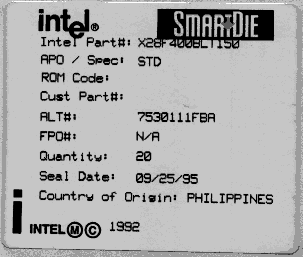Functional Analysis/Correlation Requests (FA/CR)
Die Products customers can return die that is suspected of being
defective through the same channels as packaged product. THE DIE
MUST BE REMOVED FROM THE MODULE/SUBSTRATE BEFORE BEING RETURNED
TO INTEL FOR ANALYSIS.
- DIE LEVEL BURN-IN AND TEST DIE (uProcessors and Chip Sets)
- Prior to retesting DLBI/T die, the bonds must be removed from
the bond pads. Intel has developed a procedure to remove the gold
ball bonds. Once the ball bonds have been removed the die is placed
in the DLBI/T die carrier (temporary package) for functional testing.
If emission microscopy or liquid crystal analysis is required,
the returned die will be die attached and wirebonded in a standard
semiconductor package.
- SMARTSORT
- SmartSort die (Flash products) must also be removed from the
module or substrate before being returned to Intel for analysis.
Intel has developed a procedure to retest SmartSort die on a wafer
probe station, and is evaluating die carriers that can be used
for functional testing of returned die. The gold removal process
is also used with this test procedure.
Effective functional/failure analysis and corrective action is
dependent upon historical records and information. TRACEABILITY
TO PROCESSING RECORDS FOR INTEL DIE IS THROUGH INFORMATION ON
THE LABEL OF THE GELPAK. THERE ARE NO MARKINGS ON THE DIE THAT
PROVIDE TRACEABILITY TO INTEL'S LOT PROCESSING RECORDS. It is
important that the users of die products retain the FPO number
and ALT number with their module/substrate records. This is also
important should Intel ever have to recall product. See Figure
1 below for an example of a Gel-Pak label.

Figure 1 : Gel-Pak Label for SmartSort Products
Intel will provide available information regarding procedures
for removal of die from the module or substrate as they are developed
and refined. Please contact your local Field Sales Office or SMD
Q&R for this information.
Appendix A -- Moisture Reliability
Listed below are descriptions of moisture reliability tests that
Intel performs on packaged devices. These are provided as a reference
for SmartDie customers that will be encapsulating/packaging SmartDie
to provide physical and environmental protection and moisture
resistance for the die. Intel makes every effort to minimize the
impact of moisture during the processing and shipment of SmartDie
products. The manufacturing environment minimizes the exposure
of die to moisture through careful handling procedures. SmartDie
are shipped in Gel-Paks and sealed in an anti-static moisture
barrier bag (MBB) with desiccant. The seal date is printed on
the label attached to the bag. The MBB with SmartDie do not need
to be placed in a moisture controlled environment (Clean dry air
or Nitrogen) as long as the bag remains sealed. The Gel-Pak should
be stored within a temperature range of 0-70°C (maximum ratings).
It is recommended that the moisture barrier bag remain sealed
until the die are to be used. If it is necessary to open the MBB
prior to use of the die, the Gel-Pak with die should be placed
in a nitrogen purged cabinet to prevent corrosion of the bond
pads, or the bag should be resealed per MIL-B-81705, Paragraph
4.8.1 and MIL-B-81705, Paragraph 4.8.2. NOTE: Gel-Paks should
only be opened in a clean room environment to prevent contamination
of the die by foreign material.
The customer may consider performing moisture reliability evaluations
of their encapsulated/packaged SmartDie components using similar
reliability stresses to those referenced below. During certification
of an Intel package or qualification of an Intel packaged product,
the following moisture reliability stresses may be performed:
- Surface Mount Preconditioning
- THB (Temperature Humidity Bias) - 85 degrees C/85%RH
- Steam (Autoclave)
- Biased HAST (Highly Accelerated Steam Test)
Surface Mount Preconditioning
Surface Mount Preconditioning is used to simulate the processing
conditions surface mounted devices encounter when soldered to
the printed circuit board. The procedure simulates the environmental
stresses (thermal and moisture) that a packaged device is subjected
to during the process.
THB (85 degrees C/85%RH)
This test is a high temperature/high humidity stress used to evaluate
the reliability of non-hermetic devices in humid environments.
It accelerates the moisture absorption in a plastic package by
increased humidity/temperature to induce the transport of ionic
contamination. Devices are biased to the maximum voltage level
within the operating range applied on alternate pins while maintaining
minimum overall power dissipation in an 85°C ambient with
85% relative humidity environment. If contamination is present,
it may combine with moisture to form an electrolyte. Typical failure
mechanisms from this stress include electrolytic corrosion of
metal and contamination induced threshold shifts due to moisture.
Steam (Autoclave)
The Steam stress accelerates moisture penetration through the
plastic packaging material to the surface of the die. The objective
of the test is to accelerate the problems found in very moist
environments. Failure mechanisms typically seen from this stress
include corrosion, passivation defects, leakage, and contamination.
The test chamber is maintained at a temperature of 121°C
and an absolute pressure of 2 atmospheres.
Biased HAST
The biased Highly Accelerated Steam Test (HAST) is similar to
THB (85/85) except units are subjected to more stringent conditions.
The HAST stress is run at 156°C with 85% relative humidity.
The units are biased with the maximum voltage within the operating
range applied on alternate pins while maintaining overall power
dissipation. Typical failure mechanisms from this stress include
electrolytic corrosion of metal and contamination induced threshold
shifts due to moisture.
Additional related information is available in the following literature:
- Intel Components Quality and Reliability Handbook
- Intel Packaging Handbook
- Board Solder Reflow Process Recommendations, Intel Faxback
literature #8000
- Guidelines for Handling Units in Desiccant Pack, Intel Faxback
literature #8001